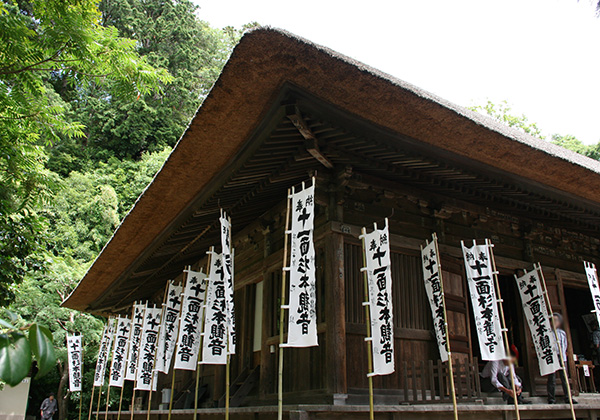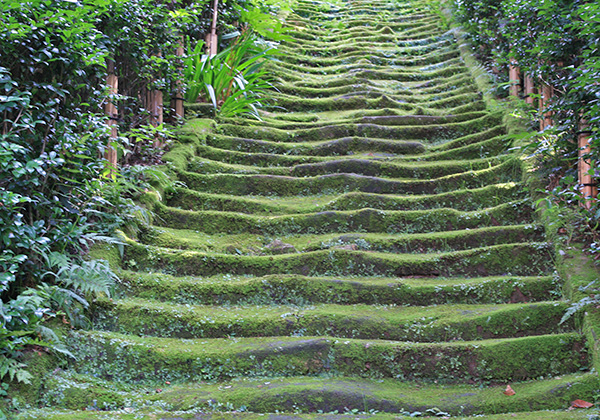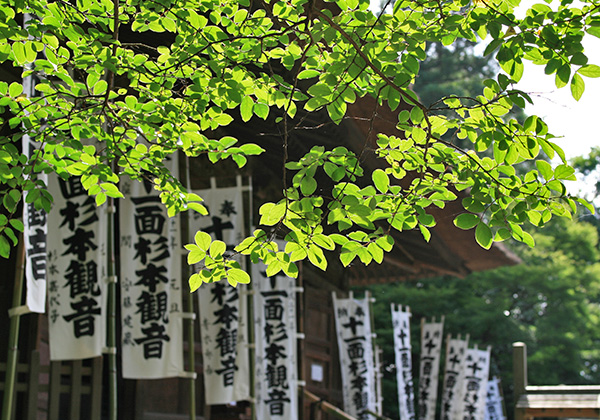Sugimoto-dera
| Official Name | Taizo-zan Kan'non-in Sugimoto-dera {Pronounced tye-zoh-zan kan-non-in soo-ghe-moh-toh-deh-rah} |
|---|---|
| Religious sect | Religious sect: Tendai sect, Buddhism |
| Founded | in circa 734 by Fusasaki Fujiwara {foo-sah-sah-kee foo-gee-wah-rah} |
| Founding priest | Gyoki {gyo-key} |
| Main object of worship | Statues of Eleven-Headed Kan'non |
| Address | 903 Nikaido, Kamakura, Kanagawa 248-0002 (show route from current location ) |
| Location | 1,600 meters north northeast of Kamakura Station |
| Time needed to get there | 20 minutes |
| Admission | JPY300 |
| Open | Weekdays 9:00-15:00, Weekends and holidays 9:00-16:00 |
| Phone number | 0467-22-3463 |
| Restrooms | Available |
Historical Overview
This is the oldest temple in Kamakura, founded well before the Kamakura Shogunate was established. The Temple's legend holds that Empress Komyo (701-760) in the Nara Period (710-794) ordered Fusasaki Fujiwara (681-737), then a high-ranking minister, and a famous priest named Gyoki (668-749) to build the Temple enshrining a statue of Eleven-Headed Kan'non, or Ekadasamukha in Sanskrit, as the main object of worship. Priest Gyoki, who was not only a famous priest in Nara, but also was a compassionate benefactor of numerous charities, fashioned the statue himself.
There are more than 1,200 temples in Japan which were more or less associated with Priest Gyoki, and for its outstanding virtue, he was conferred the honorable title of Daibosatsu or Great Bodhisattva by the emperor. The most famous temple he helped build is Todaiji in Nara, well known for its Great Buddha Statue. Commemorating the 1250th anniversary of his death (1249th to be exact), Todaiji held a Grand Memorial Service for him in November 1998. As a traditional custom, Buddhist temples in Japan hold this Grand Memorial Service for great priests every 50 years calling it Onki {on-kee}.
In 851 when another Tendai-sect priest called En'nin (794-864), (also called Jikaku {gee-kah-koo} the Great Teacher) visited here, he made a new Eleven-Headed Kan'non statue and granted it to the Temple. Again in 985, Retired Emperor Hanayama (968-1008) told Priest Genshin (942-1017), another famous priest at the time, to fashion an additional statue of Eleven-Headed Kan'non and dedicate it to the Temple. Both En'nin and Genshin were most influential priests back those days and played key roles in spreading Japanese Buddhism as priests of Enryakuji in Shiga Prefecture, the mecca of the Tendai Sect. Retired Emperor Hanayama himself once paid a visit to Sugimoto-dera and designated it as the first of the Bando (Tokyo and its neighboring prefectures) Thirty-Three Kan'non Pilgrimage. Later, it was also listed on the top of the Thirty-Three Kan'non Pilgrimage in Kamakura.
A fire of 1189 broke out in the neighborhood entirely consumed the Temple, but, says the legend, that a priest by the name of Jodai-bo rushed into the burning hall and carried out three Kan'non statues safely. Despite the raging fire, he was not burned and the three statues were undamaged taking shelter under a cedar tree. Thus, the Temple was called Sugimoto (cedar root) dera (temple) and people enhanced their faith in the Temple. Yoritomo Minamoto {yoh-re-toh-moh me-nah-moh-toh} (1147-1199), the founder of the Kamakura Shogunate, was then the commander-in-chief of the military government. He instructed to rebuild the Temple after the fire and granted a new statue of Eleven-Headed Kan'non in 1191.
Added to the four Kan'non statues above is quite a new one carved in 1963 by the then chief priest, and therefore, a total of five Eleven-Headed Kan'non statues are enshrined in the Temple.
With respect to the oldest Kan'non statue, there is an anecdote prevailed at a time when Tokiyori Hojo {toh-key-yoh-re hoe-joe} (1227-1263) was in power as the Fifth Hojo Regent. If someone who do not have faith in Buddhism passed the road in front of the Temple on horseback, he was often thrown off. Hearing this story, Priest Rankei {ran-kay} (1213-1278), the founding priest of Kenchoji, visited here to pray and put a Kesa {keh-sah} or Buddhist surplice on the face of the Kan'non statue made by Priest Gyoki. Thereafter, no one did fall from a horse. Hence the Temple was also called Fukumen {foo-koo-men} (masked) or Geba {geh-bah} (dismounting) Kan'non.
Soon after the Kamakura Shogunate ended with the collapse of Hojo regime, there was a bitter battle in 1337 between the Imperial Court forces and the remnants of Hojo clan. Behind the Temple was a fortress, which turned the Temple into a battlefield and more than 300 samurai were killed. On the right-hand side of the courtyard, there stand a little over 100 Gorinto {go-rin-toh} or five-tier stupa, all of which were made for the repose of those who were killed at the battle.
Sugimoto-dera is one of the two Tendai sect temples in Kamakura. The other is Hokaiji.
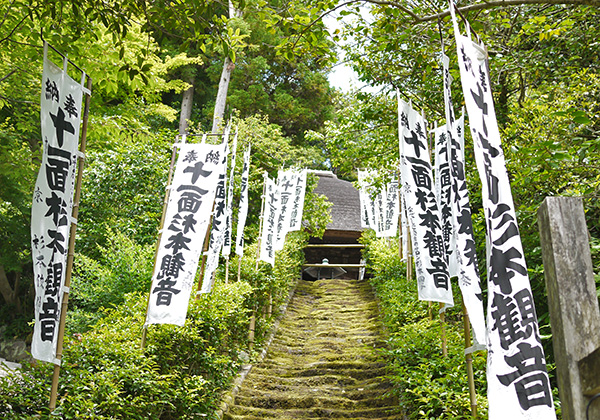
Ni-o mon {nee-oh-mon} or Deva King gate
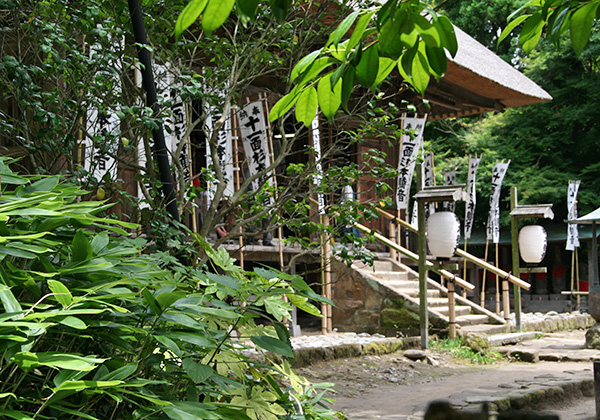
Guarded by two Deva Kings, the thatched roof gate stands halfway through the old narrow stone steps leading up to the main hall. The Temple claims that the statues were chiseled by Unkei {um-kay} (?-1223), one of the most famous Buddha statue sculptor during the Nara Period and often referred to as Japanese Michelangelo. From this gate up, the stone steps are preserved and visitors are required to keep off like the one in Myohoji. Visitors have to use left-hand side steps. On both sides of the steps, many white banner are fluttering in the wind. The Kanji characters appearing on the banners read Eleven-Headed Kan'non.
Main Hall
The nine-meter-square wooden building with thatched roofs tells us of its age. (The thatch has to be replaced every 20 years and the Temple recently began a fund-raising campaign for the renewal to be started in late 2000). It was rebuilt in 1677. Visitors are allowed to go inside, but do not forget to take your shoes and hat off. Once inside, burning incense smells and the hall is filled with smoke as well as a number of statues. Nowhere else would give us an opportunity to worship and watch Buddha statues this close. Listed below are the ones enshrined here in addition to the five Eleven-Headed Kan'non statues mentioned earlier:
Fudo Myo-o {foo-doh myo-oh}: Acalanatha in Skt. The Immovable. The God of Fire holding a sword in his right hand and a rope in his left. The sculptor is unknown.
Bishamonten {be-shah-mon-ten}: Vaisravana in Skt. One of the Four Deva Kings and the guardian of the North. Made by one of the Takuma {tah-koo-mah} family, a famous local sculptor group.
A pair of Jizo-bosatsu {gee-zoh-boh-sah-tsu}: Ksitigarbha-bodhisattva in Skt. Fashioned by Unkei and Kaikei according to the Temple. Both were among the most famous sculptors of the days. Regrettably, there is no evidence to show that the statues were really attributable to them. With these two statues of Jizo, the Temple is listed fourth and sixth among the Kamakura Twenty-Four Jizo Pilgrimage.
Statuette of Thirty-Three Kan'non installed in the right-hand recess of the hall.
Unfortunately, the three statues of Eleven-Headed Kan'non, the main objects of worship, are not viewable since they are enshrined in the feretory of the inmost recess. (To be precise, this is not a recess, but an fireproof annex to the main hall). In the center is the one fashioned by Priest En'nin which is 166 centimeters tall, and the one to your right, 142 centimeters tall, was made by Priest Genshin. Both are Important Cultural Assets. They are well carved and highly evaluated from artists' perspective. The left-side one, 153 centimeters tall, is the oldest among all of the statues in the Temple and was reportedly made by Priest Gyoki with a single bloc of wood. Academic circles cast a doubt, however, if those statues were really fashioned by such famous sculptors. Rough carving of the left one, for example, suggests the sculptor was untrained.
As is common in these cases, no clear evidences exist. The statue made by Priest Gyoki is an ICA designated by the Municipal Government of Kamakura. On the pillars and beams, quite a few paper slips are plastered with Chinese characters written on them. They are called Senja-fuda {sen-jah foo-dah}. Devout pilgrims plaster those papers in commemoration and recognition of the visit and prayer hoping their wishesbe answered. On those Senja-Fuda, their names and addresses etc. are printed.
